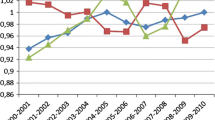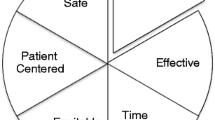Abstract
This study investigates potential changes in hospital performance after health system entry, while differentiating between hospital technical and cost efficiency and hospital profitability. In the first stage we obtained (bootstrapped) data envelopment analysis (DEA) efficiency scores. Then, genetic matching is used as a novel matching procedure in this context along with a difference-in-difference approach within a panel regression framework. With the genetic matching procedure, independent and health system hospitals are matched along a number of environmental and organizational characteristics. The results show that health system entry increases hospital technical and cost efficiency by between 0.6 and 3.4 % in four alternative post-entry periods, indicating that health system entry has not a transitory but rather a permanent effect on hospital efficiency. Regarding hospital profitability, the results reveal an increase in hospital profitability only 1 year after health system entry, and the estimations suggest that this effect is a transitional phenomenon. Overall, health system entry may serve as an appropriate management instrument for decision makers to increase hospital performance.
Similar content being viewed by others
References
Rosko MD, Proenca J, Zinn JS, Bazzoli GJ (2007) Hospital inefficiency: what is the impact of membership in different types of systems? Inquiry 44:335–349
Nauenberg E (1999) Network structure and hospital financial performance in New York State: 1991–1995. Med Care 56(4):415–439. doi:10.1177/107755879905600402
Oliver C (1990) Determinants of interorganizational relationships: integration and future directions. Acad Manag Rev 15:241–265
Rosko MD, Proenca J (2005) Impact of network and system use on hospital X-inefficiency. Health Care Manag Rev 30:69–79
Bazzoli GJ, Shortell SM, Dubbs N, Chan C, Kralovec P (1999) A taxonomy of health networks and systems: bringing order out of chaos. Health Serv Res 33:1683–1717
Shortell SM, Bazzoli GJ, Dubbs NL, Kralovec P (2000) Classifying health networks and systems: managerial and policy implications. Health Care Manag Rev 25:9–17
Simar L, Wilson PW (2000) A general methodology for bootstrapping in non-parametric frontier models. J Appl Stat 27:779–802. doi:10.1080/02664760050081951
Sekhon JS (2011) Multivariate and propensity score matching software with automated balance optimization: the matching package for R. J Stat Softw 42:1–52
Diamond A, Sekhon JS (2013) Genetic matching for estimating causal effects: a general multivariate matching method for achieving balance in observational studies. Rev Econ Stat 95:932–945. doi:10.1162/REST_a_00318
Simar L, Wilson PW (2007) Estimation and inference in two-stage, semi-parametric models of production processes. J Econom 136:31–64. doi:10.1016/j.jeconom.2005.07.009
Herwartz H, Strumann C (2012) On the effect of prospective payment on local hospital competition in Germany. Health Care Manag Sci 15:48–62. doi:10.1007/s10729-011-9180-9
Williamson OE (1985) The economic institutions of capitalism: firms, markets, relational contracting. Free Press, New York
Pfeffer J, Salancik GR (1978) The external control of organizations. New York
Williamson OE (1991) Comparative economic organization: the analysis of discrete structural alternatives. Adm Sci Q 36:269–296. doi:10.2307/2393356
Shortell S, Bazzoli GJ, Dubbs N, Kravolec P (2000) Classifying Health Networks and Systems: Managerial and Policy Implications. 25 (4):9–17
Alexander JA, Lee S-YD, Bazzoli GJ (2003) Governance Forms in Health Systems and Health Networks. 28 (3):228–242
Carey K (2003) Hospital cost efficiency and system membership. Inquiry 40:25–38
Proenca EJ, Rosko MD, Dismuke CE (2005) Service collaboration and hospital cost performance: direct and moderating effects. Med Care 43:1250–1258. doi:10.2307/3768212
Bazzoli GJ, Chan B, Shortell SM, D’Aunno TA (2000) The financial performance of hospitals belonging to health networks and systems. Inquiry 37:234–252
Tennyson DH, Fottler MD (2000) Does system membership enhance financial performance in hospitals? Med Care Res Rev 57:29–50
Hollingsworth B (2008) The measurement of efficiency and productivity of health care delivery. Health Econ 17:1107–1128. doi:10.1002/hec.1391
Tiemann O, Schreyögg J (2012) Changes in hospital efficiency after privatization. Health Care Manag Sci 15:310–326. doi:10.1007/s10729-012-9193-z
Fottler M (1987) Health care organizational performance: present and future research. JMS 13:367–391
Federal Statistical Office of Germany (2013) Krankenhausstatistik (Teil I: Grunddaten, Teil II: Diagnosen und Teil III: Kostennachweis) der Jahre 2000–2011, Antrag 2216–2013
Herr A, Schmitz H, Augurzky B (2011) Profit efficiency and ownership of German hospitals. Health Econ 20:660–674. doi:10.1002/hec.1622
Lindlbauer I, Schreyögg J (2014) The relationship between hospital specialization and hospital efficiency: Do different measures of specialization lead to different results? Health Care Manag Sci online published first. doi:10.1007/s10729-014-9275-1
Schmid A, Ulrich V (2013) Consolidation and concentration in the German hospital market: the two sides of the coin. Health Policy 109:301–310. doi:10.1016/j.healthpol.2012.08.012
Jacobs R (2001) Alternative methods to examine hospital efficiency: data envelopment analysis and stochastic frontier analysis. Health Care Manag Sci 4:103–115
Rego G, Nunes R, Costa J (2010) The challenge of corporatisation: the experience of Portuguese public hospitals. 11 (4):367–381. doi:10.1007/s10198-009-0198-6
Charnes A, Cooper W, Rhodes E (1978) Measuring the efficency of decision making units. Eur J Oper Res 6:89–107
Banker R, Charnes A, Cooper W (1984) Some models for estimating technical and scale inefficiencies in data envelopment analysis. Manag Sci 30:1078–1092. doi:10.1287/mnsc.30.9.1078
Jacobs R, Smith P, Street A (2006) Measuring efficiency in health care: analytic techniques and health policy. Cambridge University Press, Cambridge
Linna M (1998) Measuring hospital cost efficiency with panel data models. Health Econ 7:415–427. doi:10.1002/(SICI)1099-1050(199808)7:5<415::AID-HEC357>3.0.CO;2-9
Smith PC (1997) Model misspecification in data envelopment analysis. Ann Oper Res 73:233–252. doi:10.1023/A:1018981212364
Simar L, Wilson PW (1998) Sensitivity analysis of efficiency scores: How to bootstrap in nonparametric frontier models. Manag Sci 44:49–61. doi:10.1287/mnsc.44.1.49
Team RDC (2013) R: A language and environment for statistical computing. R Foundation for Statistical Computing, Vienna
Wilson P (2008) FEAR: a software package for frontier efficiency analysis with R. Socio Econ Plan Sci 42:247–254. doi:10.1016/j.seps.2007.02.001
Herr A (2008) Cost and technical efficiency of German hospitals: does ownership matter? Health Econ 17:1057–1071. doi:10.1002/hec.1622
Dyson RG, Allen R, Camanho AS, Podinovski VV, Sarrico CS, Shale EA (2001) Pitfalls and protocols in DEA. Eur J Oper Res 132:245–259. doi:10.1016/S0377-2217(00)00149-1
Jones AM (2007) Identification of treatment effects in Health Economics. 16 (11):1127–1131. doi:10.1002/hec.1302
Blundell R, Dias M (2000) Evaluation methods for nonexperimental data. Fiscal Stud 21:427–468. doi:10.1111/j.1475-5890.2000.tb00031.x
Rubin DB (2007) The design versus the analysis of observational studies for causal effects: parallels with the design of randomized trials. Stat Med 2007 26(1):20–36. doi:10.1002/sim.2739
Rosenbaum P, Rubin D (1985) Constructing a control group using multivariate matched sampling methods that incorporate the propensity score. ASA 39:33–38. doi:10.1080/00031305.1985.10479383
Rubin D (1979) Using Multivariate Sampling and Regression Adjustment to Control Bias in Observational Studies. 74:318–328
Rubin D (1980) Bias Reduction Using Mahalanobis-Metric Matching. 36 (2):293–298
Mebane WRJ, Sekhon JS (1998) R-GENetic optimization using derivatives (RGENOUD). Accessed 2014/04/21
Morgan S, Harding D (2006) Matching estimators of causal effects: prospects and pitfalls in theory and practice. SMR 35:3–60. doi:10.1177/0049124106289164
Frey S, Stargardt T (2012) Performance of compliance and persistence measures in predicting clinical and economic outcomes using administrative data from German sickness funds. Pharmacotherapy 32:880–889. doi:10.1002/j.1875-9114.2012.01120
Ramsahai R, Grieve R, Sekhon JS (2011) Extending iterative matching methods: an approach to improving covariate balance that allows prioritisation. Health Serv Outcomes Res Method 11:95–114. doi:10.1007/s10742-011-0075-5
Sekhon JS, Grieve R (2008) A new non-parametric matching method for bias adjustment with applications to economic evaluations
Sekhon JS, Grieve R (2012) A matching method for improving covariate balance in cost-effectiveness analysis. Health Econ 21:695–714. doi:10.1002/hec.1748
Abadie A, Imbens G (2006) Large sample properties of matching estimators for average treatment effects. Econometrica 74:235–267. doi:10.1111/j.1468-0262.2006.00655.x
Bertrand M, Duflo E, Mullainathan S (2004) How much should we trust differences-in-differences estimates? QJE 119:249–275. doi:10.1162/003355304772839588
Austin P (2009) Some methods of propensity-score matching had superior performance to others: results of an empirical investigation and Monte Carlo simulations. Biom J 51:171–184. doi:10.1002/bimj.200810488
Austin P, Mamdani M (2006) A comparison of propensity score methods: a case-study estimating the effectiveness of post-AMI statin use. Stat Med 25:2084–2106. doi:10.1002/sim.2328
Normand S, Landrum M, Guadagnoli E, Ayanian J, Ryan T, Cleary P, McNeil B (2001) Validating recommendations for coronary angiography following an acute myocardial infarction in the elderly: a matched analysis using propensity scores. J Clin Epidemiol 54:387–398. doi:10.1016/S0895-4356(00)00321-8
Provan KG (1984) Interorganizational cooperation and decision making autonomy in a consortium multihospital system. Acad Manag Rev 9:494–504. doi:10.2307/258289
Dranove D, Durkac A, Shanley M (1996) Are multihospital systems more efficient? Health Aff 15:100–104. doi:10.1377/hlthaff.15.1.100
Williamson OE (1975) Markets and hierarchies: a study in the internal organizations: analysis and antitrust implications. Free Press, New York
Wilcox-Gök V (2002) The effects of for-profit status and system membership on the financial performance of hospitals. Appl Econ 34:479–489. doi:10.1080/00036840110044180
Chukmaitov AS, Bazzoli GJ, Harless DW, Hurley RE, Devers KJ, Zhao M (2009) Variations in inpatient mortality among hospitals in different system types, 1995 to 2000. Med Care 47:466–473. doi:10.1097/MLR.0b013e31818dcdf0
Madison K (2004) Multihospital system membership and patient treatments, expenditures, and outcomes. Health Serv Res 39:749–769
Acknowledgments
This study was supported by a research grant from the Federal Ministry of Education and Research (BMBF) in Germany (Grant number: 01FL10055). The sponsor had no role in the study design, collection and analysis of data; the writing of the report; or the submission of the paper for publication. The authors declare that they have no conflicts of interest.
Author information
Authors and Affiliations
Corresponding author
Appendix Table 1. Balance in measured covariates before and after matching
Appendix Table 1. Balance in measured covariates before and after matching
Unmatchend sample | Matched sample | |||||
|---|---|---|---|---|---|---|
Group | Intervention (n = 399) | Control (n = 465) | di (%) | Intervention (n = 399) | Control (n = 399) | di (%) |
Mean | Mean | Mean | Mean | |||
Weighted cases (in 1,000) | 9.7 | 11.3 | 6.4 | 9.7 | 9.5 | 1.6 |
Beds | 297.5 | 340.8 | 4.9 | 297.5 | 292.4 | 1.1 |
Leased beds | 0.071 | 0.051 | 9.3 | 0.071 | 0.071 | 0.9 |
Market concentration | 0.196 | 0.200 | 2.4 | 0.197 | 0.193 | 1.2 |
Technical efficiency | 0.598 | 0.604 | 3.7 | 0.598 | 0.598 | 0.7 |
Cost efficiency | 0.338 | 0.360 | 2.8 | 0.320 | 0.321 | 0.6 |
Operating margin | 0.013 | 0.015 | 11.9 | 0.013 | 0.016 | 5.3 |
ROI | 0.007 | 0.019 | 3.2 | 0.007 | 0.009 | 1.7 |
EBIT | −56,711 | 243.282 | 20.2 | −56,711 | −56,469 | 4.0 |
EAT | 75.463 | 239.331 | 8.5 | 75.463 | 78.281 | 4.7 |
Rights and permissions
About this article
Cite this article
Büchner, V.A., Hinz, V. & Schreyögg, J. Health systems: changes in hospital efficiency and profitability. Health Care Manag Sci 19, 130–143 (2016). https://doi.org/10.1007/s10729-014-9303-1
Received:
Accepted:
Published:
Issue Date:
DOI: https://doi.org/10.1007/s10729-014-9303-1




